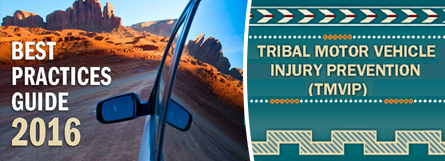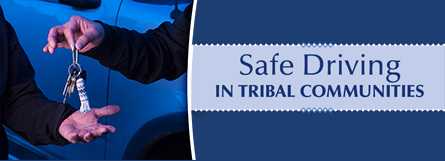Tribal Road Safety
 Motor vehicle crashes are the leading cause of unintentional injury for American Indians/Alaska Natives (AI/AN) ages 1 to 44. Adult motor vehicle-related death rates for AI/AN are 1.5 times more than that of whites and that of blacks.
Motor vehicle crashes are the leading cause of unintentional injury for American Indians/Alaska Natives (AI/AN) ages 1 to 44. Adult motor vehicle-related death rates for AI/AN are 1.5 times more than that of whites and that of blacks.
Although each AI/AN community is politically and culturally unique, effective strategies can be tailored to meet the specific needs of tribes.
Best Practices Guide
The Tribal Motor Vehicle Injury Prevention (TMVIP) Best Practices Guide 2016 provides recommended strategies and examples from Indian Country to increase seat belt use, increase child safety seat use, and reduce alcohol-impaired driving. The Guide also outlines five important components for TMVIP.
Tribal Road Safety Tool Kit
Check out CDC's Tribal Road Safety Tool Kit and share the materials to help reduce crash-related injuries and deaths among members of tribal nations.
A Killer in Indian Country video
 This video highlights the important steps to save lives and reduce injuries in tribal communities, including increasing child safety seat use, increasing seat belt use and decreasing alcohol-impaired driving.
This video highlights the important steps to save lives and reduce injuries in tribal communities, including increasing child safety seat use, increasing seat belt use and decreasing alcohol-impaired driving.
Native American Road Safety Feature Article
 CDC's Injury Center works with tribal nations to implement motor vehicle injury prevention programs. Learn about American Indian/Alaska Natives' risks on the road and how CDC-funded programs are helping to improve road safety for Native Americans.
CDC's Injury Center works with tribal nations to implement motor vehicle injury prevention programs. Learn about American Indian/Alaska Natives' risks on the road and how CDC-funded programs are helping to improve road safety for Native Americans.
- Page last reviewed: December 9, 2016
- Page last updated: December 9, 2016
- Content source:
- Centers for Disease Control and Prevention,
- National Center for Injury Prevention and Control,
- Division of Unintentional Injury Prevention


 ShareCompartir
ShareCompartir


